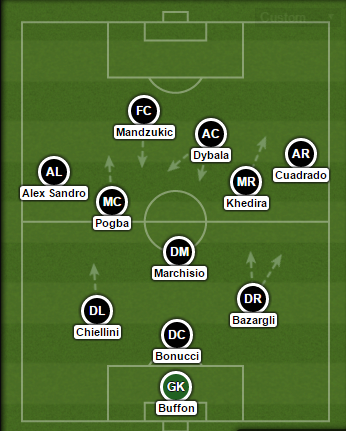
Here is an explaination on how the system works and its advantages and disadvantages as written by Adam Clark on SBNation.
The 4-2-3-1 splits players into four bands. The defensive unit consists of the standard centre-backs and full-backs and two defensive midfielders screening them, often called the ‘double pivot’.
The attacking unit consists of a band of three attacking midfielders and a lone central striker. The wide midfielders are generally fast dribblers who like to cut inside or make runs into the box. The attacking central midfielder, often the ‘No. 10′, is normally a creative passer who can play balls into the feet of either the wide attackers or the lone striker.
Advantages
A good 4-2-3-1 is a formation that has a wonderful ‘springy’ quality – it absorbs pressure without breaking and then snaps back with surprising force.
In defence the 4-2-3-1 covers space very effectively, with the band of three and the lone striker able to press the opposition high up the pitch while the two defensive midfielders ensure that there is no space left in front of the defence. Then the back four can either play a high line, compressing the space even further, or drop deeper as preferred.

once the ball is won back, often by the defensive midfielders, the 4-2-3-1 can spring into attack.
The full-backs can surge up the wings in the knowledge that the defensive midfielders can drop into the space left behind if needed. As they come up the wings, the wide attackers come inside and they tend to be fast dribblers who look to get into the box.
The attacking central midfielder, often the ‘No. 10′ who is the most creative player on the team will look to play them or the lone striker in via fast passing combinations.
If the rapid attack fails, the 4-2-3-1 is well set-up to either retain possession, with a large number of passing triangles naturally formed by its four bands of players, or to press and regain the ball quickly.
Disadvantages
hile at its best the 4-2-3-1 is a masterpiece of flexibility, when played poorly it can be slow and cumbersome.
If the midfield bands are forced back and compressed into a 4-5-1, the striker can be left isolated with very little support. The full-backs, key to modern attacking football, can also be trapped behind their midfield line.

Or the opposite may happen, where the attacking band of midfielders neglect to track back and help their full-backs, allowing opposition wide players to overload the defence. This is similar to the possible problems in a 4-3-3, if the attacking wide players forget their duty to help the team when out of possession. However it can be even more pronounced as the two defensive midfielders are left with a huge amount of the pitch to cover.
Juanma Lillo, former Real Sociedad coach, is generally accepted to have been the first to consciously use the 4-2-3-1 in pursuit of the best distribution of players across the pitch to achieve two key aims – possession and pressing, retaining the ball and regaining it quickly.